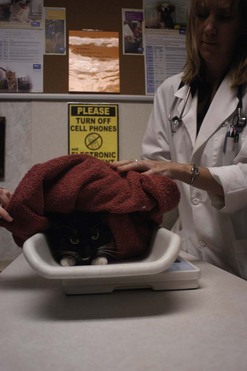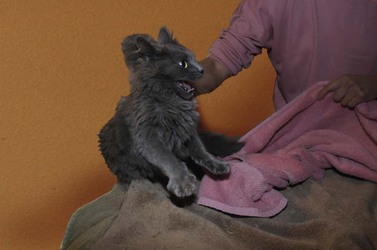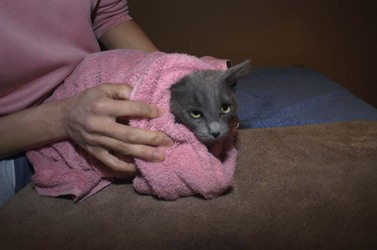Chapter 23 Reducing stress and managing fear aggression in veterinary clinics
INTRODUCTION: THE PROBLEM WITH THE STATUS QUO
THE SOLUTION: SET UP THE HOSPITAL AND HANDLING TO HELP THE PATIENT FEEL COMFORTABLE AND SAFE
STEP 1: BEFORE THE PATIENT COMES IN: WHAT THE OWNER CAN DO AT HOME
STEP 2: PREPARING THE HOSPITAL
STEP 3: GREETING THE PET APPROPRIATELY
STEP 4: HANDLING THE PET IN A CALM, SKILLED MANNER
STEP 5: DESENSITIZATION AND COUNTERCONDITIONING THE FEARFUL PET
STEP 6: SCHEDULING DS/CC TECHNICIAN SESSIONS AS AN ADDED-VALUE SERVICE
Introduction: the problem with the status quo
Many participants in this typical scenario might ask, “What’s the harm? It’s what we’ve always done.” Well, the harm is threefold. First, dog and cat bites as well as cat scratches are often the top causes of veterinary hospital staff injuries. Force-based techniques and crude handling skills undoubtedly play a significant role in these statistics. Second, for those of us who vowed to first “do no harm” as a veterinarian, every time we force pets in this manner or even handle pets in a rushed, careless way, we risk breaking this promise. We may send the patients home medically better, but they may also be leaving with a “behavioral injury.” That’s because, with each bad experience, difficult behavior and fear can worsen until they are no longer treatable. Even more ominous is the fact that a bad experience at the veterinary hospital can cause some pets to be worse with people overall. For an animal that comes in and is already slightly fearful of unfamiliar people or who has a genetic predisposition toward this trait, one bad experience can exacerbate the situation, from a pet that’s just fearful of some people occasionally to one who has a generalized and pronounced fear and suspicion of anyone new. Or worse, one that becomes fear-aggressive. The veterinary staff could, potentially, be the inciting factor that triggers this dramatic turn for the worse, which ultimately can contribute to the decision to euthanize (Figures 23.1 and 23.2).
The solution: set up the hospital and handling to help the patient feel comfortable and safe
This chapter provides a six-step approach to setting your hospital up to help reduce stress while increasing hospital efficiency. The predominant idea is that if we provide an environment where the animal feels comfortable and safe while also providing clear guidance regarding what we want the animal to do, the pet will be less fearful and more cooperative which in turn will help us get through the procedures more quickly both now and on future visits. This chapter represents an overview of each principle. For a more detailed description and techniques refer to the book and DVD set: Low Stress Handling, Restraint and Behavior Modification of Dogs & Cats (CattleDog Publishing, www.lowstresshandling.com). The six steps are as follows:
Step 1: before the patient comes in: what the owner can do at home
Counterconditioning and desensitization to crates and car rides
Car rides
For those people who are traveling alone and the pet will take treats, treats can be placed in a Kong toy (canned food, cheese or peanut butter works best). Alternately a Manner’s Minder (www.mannersminder.net)can be used to dispense treats by remote control or automatically at regular intervals.
Step 2: preparing the hospital
The entry area and waiting room
Ideally a hospital should have a separate cat area and dog area and additional visual dividers within each section. That way, those pets who are afraid of other animals can feel somewhat safe. If your hospital has not been built with separate areas already, inexpensive portable dividers can be strategically placed. Within those species-specific areas, further divide the space by using half-walls, information displays, screens, planters, fish tanks, and partitions so pets can avoid direct eye contact with other pets. Alternately you might schedule separate times for dogs and cats. Pheromone diffusers in the waiting room may also help calm pets (see Chapter 9).
The exam room
Rooms should have a handy supply of towels, especially when dealing with cats. One of the best techniques for putting fearful cats (and some small dogs) at ease is providing a way for them to hide. Often when allowed to hide under a towel, an entire examination can be done on an otherwise untreatable cat (Figure 23.3).

(Photo courtesy of Dr. Sophia Yin. From Low Stress Handling, Restraint and Behavior Modification of Dogs & Cats by Sophia Yin, DVM, MS, Cattle Dog Publishing, 2009. www.lowstresshandling.com.)
Stay updated, free articles. Join our Telegram channel

Full access? Get Clinical Tree




